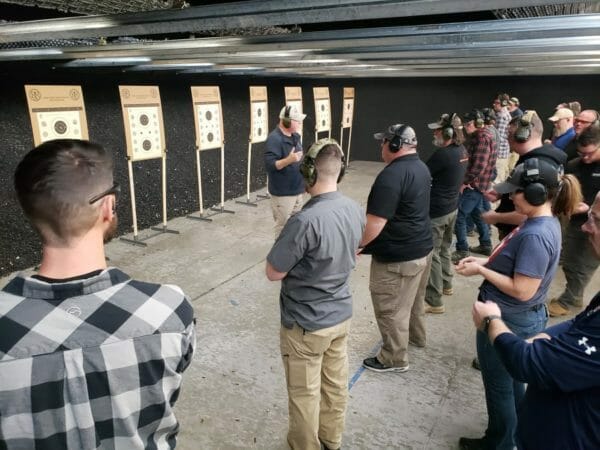
U.S.A. –-(AmmoLand.com)- Recently I finished a journey that began in the Summer of 2019. The Rangemaster instructor program consists of three courses, spanning a total of eight days and 64+ hours, and is widely regarded as the finest instructor development program in the US. With a washout rate hovering around 15%, students are required to pass several shooting tests and one written test across the three courses. The Master Instructor course is the culmination of everything, with just a few dozen shooters holding the rating as of the time of this writing. Over three days I took 46 pages of notes, with the below being my summary and review of the Rangemaster Master Instructor Development Course.
Location
The Royal Range, Nashville, Tennessee.
Weather
The weather was cold with mild snow and slush. Luckily the foul weather wasn’t a factor due to the entirety of class happening indoors.
Equipment
For the majority of the class, I used a Glock 19 outfitted with a Holosun 509T riding on a C&H Precision MOS plate. This was carried in a KSG Armory Halcyon AIWB holster. Aside from a single 45 degree Esstac Kywi, spare magazines are carried in my pockets. For Mirror-Image shooting, I opted for a PHLster Pro holster.
During the revolver portion of class, I used a 2.5” barrel Smith & Wesson Model 19. This was carried in a JM Custom Kydex AIWB holster. Speedloaders consist of Safariland Comp2, a Jetloader, and HKS loaders carried in a Speedbeez pouch worn IWB, and multiple JOX Loader Pouches. For partial reloads I used a Galco 2x2x2 pouch mounted on my belt.
Personnel
The class consisted of 20 students, two of which were women. Ages range from the mid-’20s to mid-’50s, with people coming from as far as Washington State, California, and Georgia. Backgrounds include law enforcement, former military, a middle school principal, and more. Of note, Greg Ellifritz of Active Response Training, and Karen Whitlock of TriggerTime are among my peers in class.

Tom has two assistant instructors for this course, Aqil Qadir and Chris Norville of Citizen’s Safety Academy. Both of these men are among the few instructors actually on Rangemaster staff, being excellent shooters and instructors themselves.
Student equipment
For the semiautomatic portions of the class, all students shot from concealment, with most choosing AIWB as their preferred method of carry. The vast majority of students shot Glocks of varying types, with a handful of M&P’s, a single H&K VP9, one SIG P320, and one Staccato making up the rest. Everyone shot 9mm pistols, outside of the revolver portion of class. A few shooters chose to use compensators on their pistols, and a few more used WML’s, specifically the Surefire X300U and Streamlight TLR-1HL. Only four shooters were exclusively using iron sights, which is the first time I’ve seen a Rangemaster class favoring optics. Optics include the Trijicon RMR and SRO, Holosun 507c, and Aimpoint ACRO.
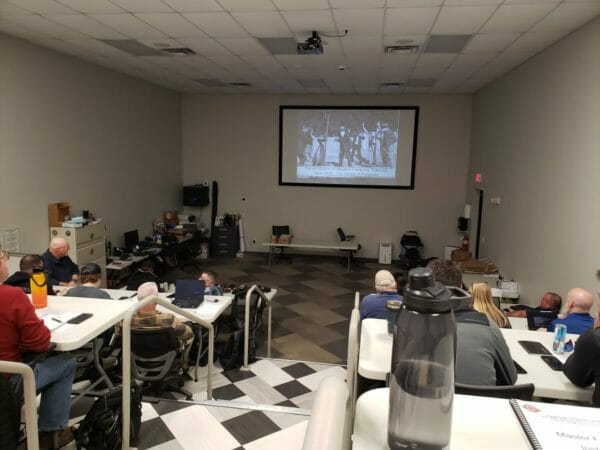
For the revolver portion of class, the majority of shooters used OWB holsters. These were a mix of leather and polymer or kydex, pretty evenly split between EDC, competition, and duty style holsters. Revolvers were primarily from Smith & Wesson, with a few Ruger GP100’s, and three Chiappa Rhino’s, with everyone shooting .38 Special guns. Interestingly, a few shooters had such low confidence in their revolver (or revolver skills) that they opted to wear their normal EDC guns concealed, in addition to their OWB revolvers.
Day 1 of the Rangemaster Master Instructor Development Course
Classroom Academics
Day one begins with introductions from the whole class, an overview of the weekend’s agenda, and a safety briefing. The first topic we jump into is the evolution of modern firearms training, with a focus on training from 1920 to today. With this, Tom discusses 40 individuals who had a big impact on the training industry, both positively and negatively. These people include J. Henry “Fitz” Fitzgerald, Frank Hamer, Jelly Bryce, Charles Askins, William Fairbairn, Jeff Cooper, Clint Smith, Massad Ayoob, Pat Rogers, William April, and more. As part of this discussion we touch on popular training targets, advancements in holster design (such as a dedicated AIWB holster worn in 1930), the history of aimed fire versus point shooting, competition’s role in training, and a variety of other topics.
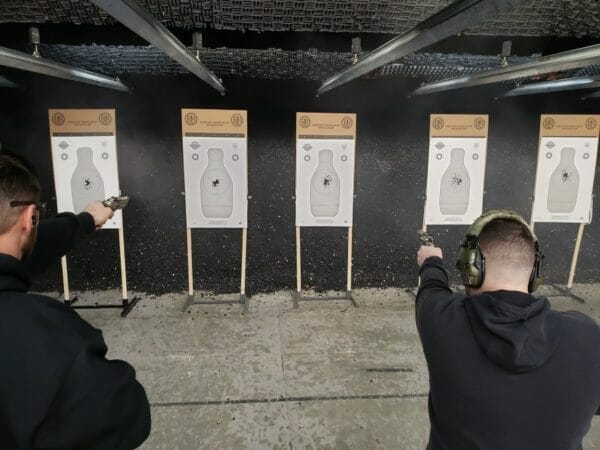
From here we move into a history of holster design, starting in 1880 and moving to today. As always, Tom’s requirements for a good holster is something that is comfortable, concealable, fast, and secure. We have to be comfortable enough to wear the holster. It must be concealable so that we’re not advertising our gun to potential threats. The gun must be readily accessible to us in case of an emergency. The gun must be secure in the holster, ensuring it doesn’t tumble out in a fall, break off in a fight, or allow unauthorized access to the trigger.
In total, we spend about half of the first day in the classroom before heading to the range. By this time I’m already on page 27 of my notebook.
Range Time
We start off our range time with some dry practice. Ammunition is expensive, so we need to break the rust off without wasting precious resources. The first target we use is the LTT-1, allowing two relays of shooters to use one sheet of paper and have a variety of targets to shoot. We fire a variety of “up” style drills to work accuracy on small circles, and increasing round counts to practice reloads and throttle control. Our first scored courses of fire are the Five Yard Roundup and the Rangemaster Advanced Bullseye Course. I score a 97/100, and a 281/300 respectively. Next we get our first chance to practice the Rangemaster Master Instructor Qualification Course, which I shoot a 231/250, landing me safely in the realm of passing.
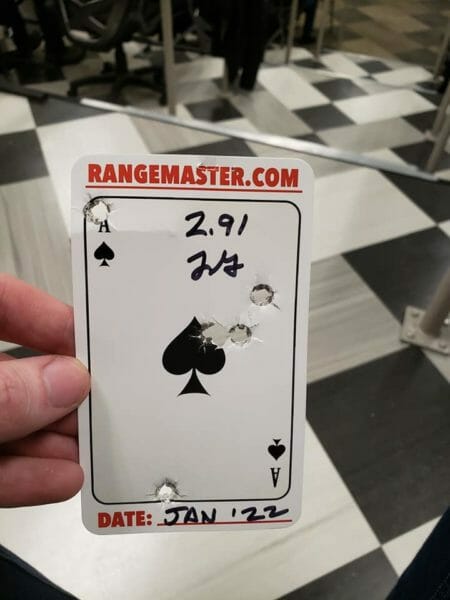
About halfway through our range time, my Ameriglo rear sight backs out enough to become unusable. Luckily my optic remains secure, allowing me to continue without much worry.
Back to the Classroom
Once we finish the day’s shooting, we return to the classroom to watch a few videos on how to present a course of fire to students. One of our requirements for class is to teach everyone a drill, demonstrate it, then run the firing line through said drill. After these examples, Tom gives us tomorrow’s expectations and sends us on our way.
Day Two of the Rangemaster Master Instructor Development Course
Classroom Academics
We begin the second day of training by watching an old Air Force training film, discussing revolver techniques from 1960. This is to show how backward most training programs were until relatively recently, even when other shooters were teaching things very similar to what we know as “right” today. This leads to a presentation on the defensive revolver, starting with its pros and cons, and preventative maintenance. Next, we talk about the history of revolver design from the pepperbox to today. This covers carriage of spare ammunition, holsters, grip design, reloading methods, and more.
Range Time with Revolvers
Tom starts off day two’s range time with a demonstration. He tells us this demo is the only time he shoots revolvers all year, firing the gun upside down with his pinky. This demonstrates that with proper sight alignment and trigger control, the orientation of the gun doesn’t particularly matter to get good hits, so falling in a fight shouldn’t worry us too much. He adds that “I’m 70 years old and just made those hits with my pinky. It also tells us don’t mess with me”.

Much like Day One, we start off working the gun dry. For our first live fire, we only load three rounds, playing a sort of Russian Roulette without target. This allows us to fire half as much ammunition for a full load of trigger presses and reloads. From here we do some strong hand only work, then go into our revolver qualification course, which I shoot a 96% on. For those carrying snubby revolvers, Tom provides time to shoot those in addition to our larger guns, with about 1/4 of the class taking him up on that.
Greg Ellifritz then takes time to run students through his snubby qualification course of fire. Since I was shooting a larger Model 19, I figured I could go full Ricky Bobby and still be solid. That was a mistake, as I miserably failed his drill. I’ll have to redeem myself on my own time soon.
Mirror Image Range Time
After lunch, we put away our revolvers and strap on our mirror image gear. This means right-handed shooters are carrying and shooting as lefties, and vice versa. The point of this exercise is twofold. First, carrying and shooting reverse is like doing everything for the first time. It allows us to remember the nuances of carry for newbies, instead of relying upon the experience we’ve built up over years. This also teaches us the different manipulations that may be required of opposite-handed shooters, especially when using non-ambidextrous pistols.

We begin simply loading and unloading our pistols for several reps, trying a few different methods to see what works best. Next, we work “up” drills out to 10 yards, building basic familiarity with our opposite side. There are no qualifications from this side, as this is simply an exercise to build knowledge.
Back to Normal
From here we return to our regular gear to fire another practice Master Instructor Qualification course. This time I score a comfy 241/250, further solidifying the likelihood of passing. After this, we begin shooting our student-led drills. We make it through roughly 1/3 of the drills before returning to the classroom.
More Classroom
Back in class, we start going over statistics for violence and defensive gun use. One of the things that set Rangemaster apart is how Tom keeps records for his students who are involved in shootings. To date, 68 of his students have been in defensive shootings. Most which have won their fight and lived to tell the tale. Only two have died, both being unarmed at the time, which Tom considers a forfeit instead of a loss. All of these students have been debriefed by Tom, allowing him to gather data on real-world incidents. He then compares these to FBI and DEA shootings, focusing on plainclothes agents, as they aren’t actively on patrol like typical law enforcement.

Interestingly, all of this data aligns well, which Tom then uses to drive his training focus. In short, his students achieve 95% accuracy, with shootings happening from contact to 22 yards (15 and 17 yards also occurring in the last 5 years), averaging three to five yards. The lowest round count for his students has been one, with 11 being the highest, and 4 being the average. To top it off, about half of these encounters involve multiple threats, with the highest number being eight attackers against one defender. I’ll dive more into this data in another article, but it’s certainly something to think of, often running counter to the typical internet mythos.
Day Three of the Rangemaster Master Instructor Development Course
Range Time
Day three begins on the range and is heavy on timed drills, starting off with the Casino Drill. I make a decent performance, making a 17.73 run, including my 1-second penalty. Our best shooter landed a 12.24 including his own 1-second penalty. Next we shoot five rounds into a playing card for time, which I clean in 2.91 seconds from concealment. We shoot the Rangemaster Advanced Bullseye Course once again, where I land a 280/300.
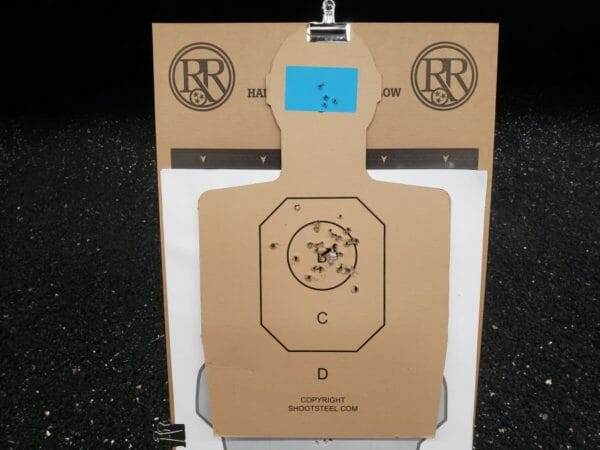
This leads us to our two Master Instructor quals, shooting at targets with reduced and then completely hidden scoring zones. These are the real deal, not just practice, and I manage a clean 100% on both runs. After this, we fire the Baseline Assessment Drill, which is also a passing requirement for the class. With this I shoot a 188/200, landing a passing 94% for my final test. Afterward, we dive back into student drills where I present the Failure Drill to class.
Classroom Academics
After we wrap up shooting, it’s time to return to the classroom. We begin with a discussion on good resources to include the works of William April, the Force Science Institute, and others. Next, we watch dashcam footage of the Dinkeller shooting, using it as a starting point to cover brain function under stress. This leads to a conversation about the differences between fear and anxiety, along with proactive and reactive violence. These topics help reinforce the importance of training, and how training can mitigate many of the problems people face under high levels of stress.
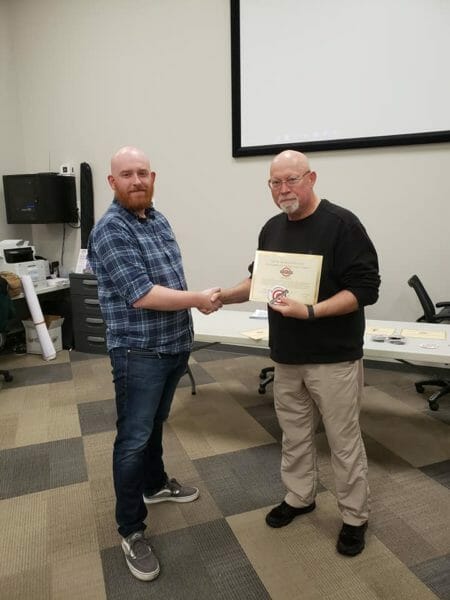
Once academics are finished, Tom presents us with our certificates. For this class, everyone passed, with Tom remarking that we were overall the best shooting class he’s ever had through the Master course. This is evident with our 3-way tie for 3rd place, a 2-way tie for 2nd place, and a Top Shot who managed 100% on all three shooting tests. After awards are passed out, everyone chats and begins packing up. With more foul weather heading our way, people head their separate ways fairly quickly to avoid being caught in the impending Snowpocalypse.
Final Thoughts on the Rangemaster Master Instructor Development Course
Going into this course, I was pretty stressed about my performance. I had some self-induced difficulties during the Advanced Instructor Course, and I wasn’t sure if those would follow me here. After years of work to get to the Master level, I didn’t want to fail. Luckily, I passed without a hitch! I was a bit surprised that our mirror image and revolver shooting didn’t count towards our final scores, as I’d been putting a lot of effort toward those skills in the months leading up to class. However, those skills still follow me and are important to maintain regardless of their importance to the class.
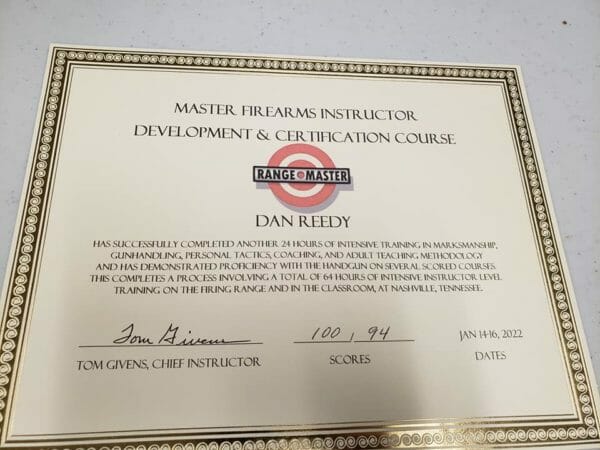
As always, Tom Givens is a master of his craft and receives far too little credit from many modern instructors and shooters. Everyone would benefit from training with him, and he sits among my top recommendations of instructors to learn from. If you are an instructor, you owe it to yourself to take a course or three with Rangemaster.
About Dan Reedy
Dan is an Air Force veteran, avid shooter, and dog dad. With a passion for teaching, he holds instructor certifications from Rangemaster, Agile Training & Consulting, and the NRA. He has trained with Darryl Bolke, Mike Pannone, Craig Douglas, among several other instructors, amassing over 400 hours of professional instruction thus far. In his spare time you’ll find him teaching handgun, shotgun, and less lethal classes.
Dan’s work has been published by Primer Peak, and The Kommando Blog, and he has been featured as a guest on Primary & Secondary.

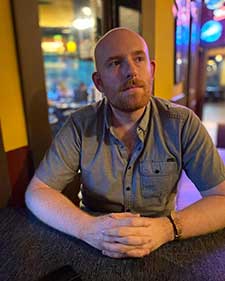
Congratulations Dan. I just signed up for Tom’s Advanced Instructor Development Course in April. His “basic” class is one of the most stressful courses I’ve ever taken. You should be super proud of passing the Master level course!
Being able to shoot is only a small portion of being a instructor. Being able to transmit information to your students is far more important. Law enforcement has gone away from instructor development courses that are more shooting. To instructor devolvement courses where one learns to be a good instructor. Rather a good shooter. When I became a State law enforcement certified instructor. Our instructor development course was 80 hours and never fired a shot. I hold instructor certifications from 3 different certifying organizations. NRA,4H and Wis. Law enforcement training and standards. In rifle, pistol, shotgun, police pistol, patrol rifle… Read more »
I would love to try Dan`s course.
You would like it. It’s worth the time and money spent. Highly recommend Dan as an instructor from whom you can learn.
But before going to buy the course, I also recommend you consider mass shootings. I have done several essays on ethical dilemma of supporting the gun industry; go to the website. It is not apparent, but you support the gun industry by sponsoring the instructor and the system or course itself by buying the course. I am not against anybody, but it’s an exciting topic to discuss for me. But as I have said you would love this course because of the high quality. It’s worth it.